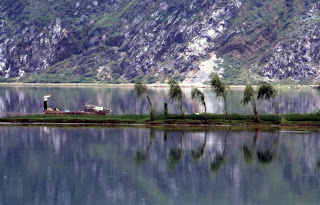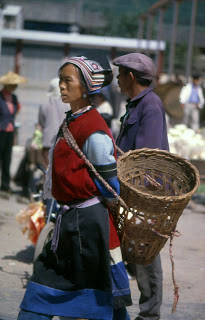by Jim Goodman
 |
| kilns on the road above Dengchuan |
Of all the places inhabited by
Yunnan’s Bai minority nationality, Dali draws by far the most attention. An historic city itself, former capital
of the ancient Kingdoms of Nanzhao and Dali, it lies on a narrow, north-south plain, bound on the east by
the 42 km-long Erhai Lake and on the west by the 19 peaks of the Azure
Mountains. Ancient pagodas and
monuments, old temples, Bai-style architecture, traditional rural and lakeside
villages and the superb scenery all entice one to extended exploration. And travelers can easily observe
traditional minority life just by wandering around in the Bai villages north of
the old town.
 |
| West Lake, Eryuan County |
For most travelers, that’s
about the only exposure they will have to Bai culture. Their next stop north is Lijiang, via
the new highway running NNE via Heqing.
A few may venture to Shaxi, in Jinachuan County, and take the old route
to Lijiang directly north through Eryuan County. But they will not stop at Eryuan city, for it is off the
main road, and will dogleg south to Shaxi well before reaching Jianchuan
city. Thus, most of Eryuan and
Jianchiuan Counties remains relatively unknown territory.
 |
| Bai villagers on the water at West Lake |
Admittedly, the scenery is not
as spectacular, for none of the mountains to the west crest over 4000 meters,
as a few near Dali do. The
lakes are smaller, mostly to the west of the road, and certainly not
appropriate for the big tour boats that cruise on Erhai. Because they are smaller, though, they
are community lakes, used by the adjacent villages as fish sources. With their fishing and farming, their
market days and religious holidays, the Bai in these two counties practice a
lifestyle every bit as traditional as the villages around Dali.
 |
| Eryuan old quarter |
After crossing a stream in
Dengchuan, the one running from West Lake to Erhai, the road rises again,
passes a long line of kilns and moves into the countryside, flanking the Er
River. This river begins in the
northwest part of the county (hence its name Eryuan—source of the Er) and is
one of the main feeders of Erhai Lake.
A little further on is the town of Yousuo, where a dirt road to the left
leads to West Lake, the first of the county’s three charming bodies of water.
It’s about a 20-minute walk to
the lake, across a flat plain of farms and villages, with mountains rising
majestically behind. The houses
are in the Bai style common around Dali, likewise behind whitewashed walled
compounds, and the women dress similarly.
West Lake village is on the northeast side of the lake and virtually
every house has a small boat. The
lake is less than four square km and not very deep, averaging 1.5 meters. Villagers paddle or pole themselves out
onto the water to fish or to dip buckets to scoop up some of the lakebed mud to
use as fertilizer for the fields. They also gather water chestnuts and a kind of edible moss
from the lake.
 |
| Eryuan Bai girl |
In recent years Dali
entrepreneurs have set up West Lake as a day’s tourist excursion. A ticket booth stands near the start of
the village, with an entrance fee of 120 yuan. But those not interested in a short
boat ride, Dali Bai dance show or buying Dali handicrafts from the little
market inside can walk past the ticket booth and stroll into the village
instead.
All the lanes seem to end in a
lakeside house or go back out to the fields, though. There doesn’t seem to be a way to circumambulate the lake on
any kind of fixed path. That could
change, however, as a result of ‘tourism development.’
Further up Route 214, but
several kilometers off to the west, is Eryuan city, 73 km north of Dali, the
biggest in the county, originally known as Jade Lake. It lies in a partly secluded valley, hardly visible from the
turn-off, backed by high mountains, with villages on all sides. Though slightly higher and further
north than Dali, it has a milder climate because the surrounding mountains
shield Eryuan Valley from the cold winds coming down from the Azure
Mountains. Two decades ago
traditional houses dominated, especially in the western part, where the weekly
market day took place. It has
modernized quite a lot since then, but the villages are still mostly
unaffected.
 |
| Eryuan market day |
Bai women dress much the same
as in Dali, with a side-fastened vest over a long-sleeved blouse, trousers,
apron and bonnet. The younger
women don a different headdress, though, with an embroidered band across the
front and pompoms tied to the top.
They also tend not to dress in white like the Dali girls, but wear red
or green vests and dark aprons and trousers.
Besides the mountains,
Eryuan’s main physical attraction is the small lake about two kilometers past
the city’s northern suburbs. About
six km long and averaging two km in width and eleven meters in depth, its
jade-green waters supposedly originated with a legendary visit by the Emperor
Jianwen in the Ming Dynasty. He
was out on the lake in his boat, enjoying the mountain scenery all around, but
disappointed in the muddy color of the lake’s water.
 |
| Cibi Lake |
Nowadays it’s called Cibi
Lake, after the cibi flower, a local
species related to the water lily that grows in the shallower parts of the
lake. In the summer months it
blooms and the white blossoms mottle the lake surface. At other seasons other flowers lie in
the offshore water. A restaurant
stands on the shore nearest the villages, but tour boats are rare, only local
fishermen row out on the lake. The
shallowest part has been bordered by nets and turned into a fishpond. A road runs around the perimeter of the
lake, but it takes several hours to walk it.
 |
| Haixihai Reservoir, Eryuan County |
Yinyinwu is a festival
designed to strengthen relationships between children and their elders. Because this is a magical day,
the older generation pays special attention to what the children say, for it
might have some hidden significance.
Groups of children march around to the houses and the elders welcome
them with firecrackers and send them off with gifts.
 |
| new Bai houses in Jianchuan |
From here the road ascends
into the hills again, enters Jianchuan County and then winds down to the town
of Diannan and the Heihui River. At
a junction just past the town, one road follows the Heihui south to Shaxi,
while the main route 214 branches north to Jianchuan. This valley, the last major Bai population center along the
route north of Dali, is at 2200 meters altitude, about 200 meters higher than
Erhai Lake and subject to cold winds in the winter from the snow peaks
northwest of the county.
 |
| Jianfeng Pavilion |
 |
| Jainchuan old quarter street |
The other major festival
specific to the county happens full moon day of the sixth lunar month at Sword
Lake, close to Diannan. This is
the main natural attraction in the area, 15 km in circumference and about 8
square km in surface area. Its
depth averages four meters, but is quite shallow near the southern shore, where
lines of nets stand in the water and fishermen pole their small boats to cast
lines. On this day people walk
around the lake, or at least along part of it, meet friends and stop for
picnics. In the evening as the
moon rises, young couples take boats out on the lake and the festival is also
popularly known as Lovers’ Rendezvous.
 |
| Bai footwear stall on market day |
 |
| Jianchuan Bai layered bonnet |
Local skills are still
alive. Homes in the old quarter
exhibit numerous examples and shops in the northern neighborhoods still market
furniture and statues. Modern
buildings fill the spaces beside the route through the city, but traditional
houses characterize the western, older half. Here are brick streets along a stream, stately old trees, an
occasional pagoda and the lovely Jianfeng Temple, featuring a three-tiered,
octagonal, Qing Dynasty pavilion.
 |
| copper ware for sale in Jianchuan |
 |
| Jianchuan Bai woman in the market |
Two years ago a new highway opened
connecting Jianchuan to Dali and reducing the journey to less than two
hours. That puts the city in the
range of a day-trip out of either Dali or Lijiang. So now travelers are more frequently stopping there to enjoy
its assets. Hopefully, the
increased attention and appreciation of Jianchuan’s special features will
inspire its people to maintain them.
*
* *


No comments:
Post a Comment